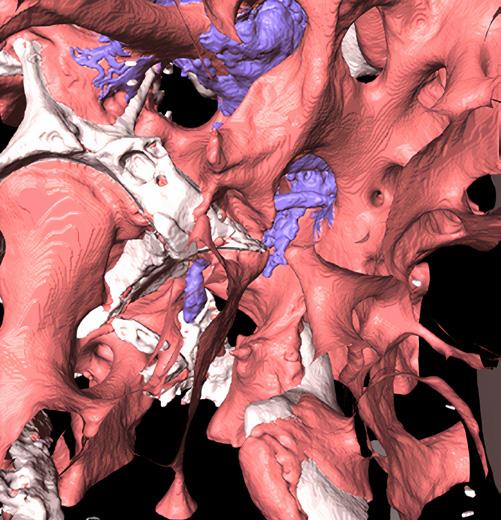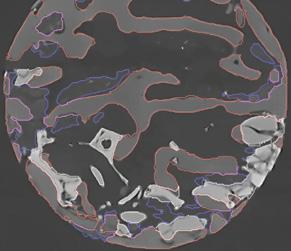
1 minute read
Navigation inside the 3-D pore structure of regenerated bone
Image analysis Navigation inside the 3-D pore structure of regenerated bone
Yong-Gun Kim | Republic of Korea Department of Periodontology, School of Dentistry, Kyungpook National University, South Korea
A
B C Fig. 1: | A High contrast micro-tomography slices allow segmentation of the newly formed bone, Geistlich Bio-Oss®, and woven bone – pixel size 1.8µm. | B & C 3-D reconstructed image of sample: purple showing the woven bone in the interface of remaining Geistlich Bio-Oss® (white) and the newly formed bone (red).

Synchrotron Radiation micro-computed tomography (SR-μCT) is based on high flux X-ray in a particle accelerator. The acquired images have a high resolution and allow simultaneous visualization of the specimen’s 3-D microstructure and quantitative analysis of the segments, along with their densities. With SR-μCT the intrinsic limitations of traditional histomorphometry microcopy, e.g., the 2-D nature of images or specimen defects during sectioning, are surmounted. It is also possible to study the bone regeneration dynamic, including the ratio and distribution of new and substitute bone and their interfaces at different times, which is not possible using conventional μCT or historical histomorphometry.

In our study, sinus floor augmentation was performed using the lateral approach and Geistlich Bio-Oss®.¹ After 6-months of uneventful healing, the bone biopsy specimens were collected during implant site preparation and cut into a cylindrical shape for tomography image acquisition (3 mm long and 2 mm diameter). After reconstruction of 3-D images from the tomography slices (Fig. 1A), the true structure of regenerated bone was revealed (Fig. 1B & C). Quantitative analysis indicated the volume fractions of new bone, Geistlich Bio-Oss® and woven bone were 29.44%, 13.39%, 13.29%, respectively.
Reference 1 Seo SJ, Kim YG.: J Synchrotron Radiat. 2020 1; 27(Pt 1):199-206.










